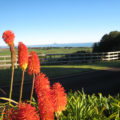The formal presentation accompanied by slides and followed by Q&A is standard fare at conferences and other corporate settings. It makes sense to capture these on video whenever possible, so that you can re-use the material and get greater returns on the investment that the presenter (and the company) have made in developing the presentation, traveling to the venue, etc.
So what’s the best way to video these things? I have a few suggestions, based on LOTS of experience.
Lighting
The setting is usually a large room with a podium at the front where the speaker rests a laptop. Slides are projected onto one or two screens to the side(s) of the speaker.
These are terrible filming conditions. At large events the speaker may be spotlighted, but more often you’re stuck with room lighting, and have to fight with people who keep wanting to turn that down so  the slides can be read more easily. Resist this tooth and nail: you have enough lighting problems even with the room lights turned up as high as they will go.
Camera Position
I’ve seen people set up a camera at the back of the room, angled to get both the presenter and the projected slides in the frame, on the assumption that this way they’re capturing everything. WRONG. The slides will be illegible at that distance, and the speaker a blurry silhouette. The resulting video won’t be good for much.
My solution is to position my camera close to the front of the room, preferably on the same side that the screen is on, shooting across the room so that the speaker’s face and upper body are framed and NOT silhouetted against the screen.
The front row is ideal, as long as that’s not so close to the speaker that he/she disappears behind the podium, and also taking into account your need to connect to a good sound source. If you can’t be in the front row, you’ll need to raise the camera up enough to shoot over the heads of the audience in front of you. I usually put my tripod on a table, and use the center column to get more height (note, however, that whenever you put a tripod on a table, you are vulnerable to people jiggling the table; it’s a tossup between that and having them trip over the legs if you put the tripod on the floor).
Give yourself room to pan the camera back and forth in case the speaker paces during the presentation. Sometimes you may think the speaker is “tethered” because the podium is on a dais or stage, but don’t count on it – you’d be surprised how mobile some speakers can be in the face of all kinds of obstacles! (NB: I’m happy for speakers to move around, if that feels natural to them – it makes for more entertaining video.)
Because I zoom in on the speaker, the slides are usually not in the picture at all (unless the speaker walks over in front of the screen and gestures at the slide). As you can see in most of the videos I’ve done for Sun, I edit the slides in afterward as video overlays. To make it easier to find the right place to put each slide, during filming I try to note the timing of slide changes.
…or try to get a corner of the screen in your shot so that you’ll be able to see on the video when the slide changes.
Sound
Try to ensure that questions from the audience will be heard on the video, either by the questioners using a floor mic or the speaker repeating the question. You can’t always enforce this, so be prepared to write down the questions as well and edit them in later as subtitles – otherwise you have video of a speaker nodding wisely in total silence, then rattling off an answer that’s unintelligible without the question.
The results of all this will not be the highest-quality video, but, especially if you take care to get good sound, it will be good enough for web use, and people worldwide who could not attend the presentation in person will be grateful that you made it available.
You can see many, many examples of my video work on my YouTube channel.


